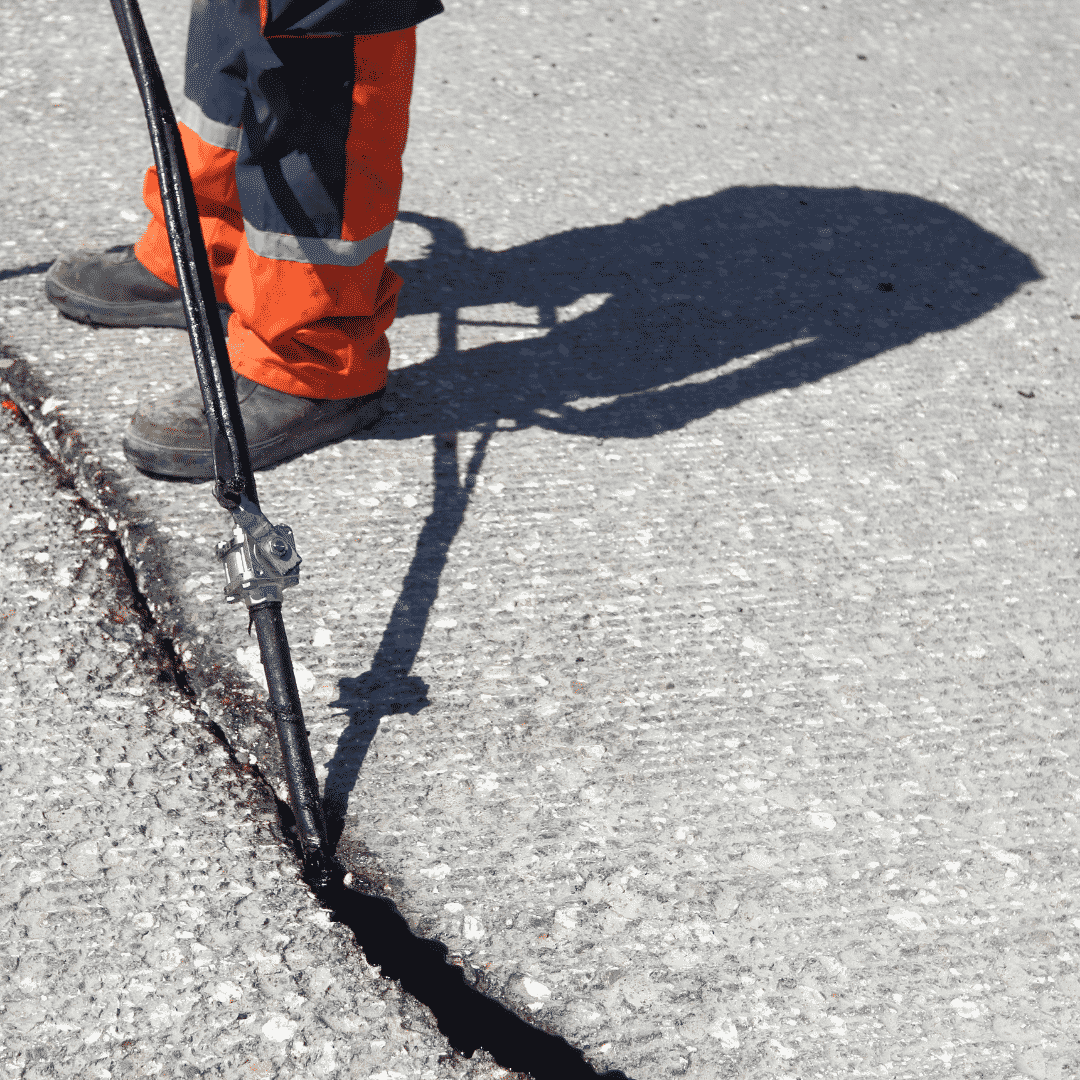Crack sealing is an important part of maintaining any asphalt surface. Over time, exposure to weather and traffic can lead to cracks, even on high-quality asphalt. By sealing cracks as soon as they appear, you can prevent bigger issues and keep your surface looking its best.
But how often should you be sealing those cracks? And why is it worth doing consistently? Understanding the difference between crack sealing and full asphalt crack repair can help you decide when each method is needed. Keep reading to learn more about why routine crack sealing is essential, and why it’s so effective for asphalt crack repairs.
The Importance of Sealing Asphalt Cracks
Crack sealing is the first line of resistance against asphalt driveway or pavement deterioration, and it’s a cost-effective way to keep your pavement in good shape. Crack sealing prevents moisture from getting into the base, which affects the binder and causes it to fail in asphalt concrete pavements. Minimizing water damage will also prevent weeds from growing. Plant development may push the pavement up, causing structural failure and potholes.
Not only does this method of asphalt crack repair prevent water and debris from getting into the cracks and causing further damage, but it also keeps the surface looking neat and tidy. Sealing cracks as soon as they form is the best way to prevent them from becoming bigger and more expensive to fix.
Crack Filling vs Crack Sealing
While the terms crack filling and crack sealing are sometimes used interchangeably, there are significant distinctions between these procedures for repairing asphalt cracks. Knowing the distinctions will assist you in determining the most cost-effective choice as well as a long-lasting solution for crack repair of your asphalt surfaces.
Crack Sealing
Crack sealing is a technique for preventing water from entering cracks by applying hot sealant to active cracks. These crack sealants are made of rubber and have the ability to seal cracks while remaining flexible with the pavement’s movement.
Crack Filling
On the other hand, crack filling is the application of asphalt emulsion into non-working cracks to prevent water from entering and to strengthen the adjacent pavement.
Read more: What is Crack Sealing?
Types of Crack Sealer
There are a variety of crack sealers on the market used for asphalt crack repairs, but there are three main types:
- Hot pour rubberized asphalt crack sealant is a viscous material that is poured into cracks and then spread across the surface with a squeegee or brush. It is the most common type of sealant and cures quickly to form a watertight seal.
- Cold pour crack filler sealant is a liquid that is poured into cracks and then troweled smooth. It sets slowly and should be used in temperatures above freezing.
- Crack banding is a pre-formed sealant that is installed over the crack using an adhesive. It is available in a variety of colors to match the surrounding surface.
Types of Asphalt Cracks
Before you choose which method is best for treating your pavement cracks, it is critical to understand the types of cracks that can occur:
Transverse Cracks
- The crack runs parallel to the pavement’s centerline or laydown direction.
- The thermal expansion and contraction of a gas are the most common reasons for this.
Longitudinal Cracks
- Longitudinal cracks, unlike transverse ones, run parallel to the pavement’s centerline or laydown direction and develop later.
- Poor lane join work, pavement shrinkage, asphalt hardening, and temperature changes are all possible causes.
Edge Cracks
- Edge cracks develop between the pavement’s edge and concrete curbs.
- Seasonal thawing allows the crack to spread and deepen, resulting in edge cracks.
Seam Cracks
- Seam cracks develop along joints of pavement.
- As a result of poor paving techniques, the asphalt layer deteriorates and becomes cracked.
Block Cracks
- Block cracks form in square pieces and are spaced between 4 to 12 feet.
- Improper construction of base courses, or a lack of drainage, are the two most common reasons.
Reflective cracks
- Reflective cracks are caused by movement in the underlying pavement.
- These cracks form when the top layer of asphalt reflects off of a weak or non-existent underlying layer. They are usually 1/8 inch to 1/4 inch wide and less than an inch deep.
Alligator Cracking
- Alligator cracking is a pattern of interconnected cracks that are extensive, congested, and resemble an alligator’s skin.
- Deterioration of the asphalt from excessive vehicle traffic, oil and gas spills, or water drainage problems are the most common reasons for this.
Now that you know the different types of cracks, how do you know which one you have? There is no definitive answer, but a good way to start is by identifying the width and depth of the crack. You can also look out for any vegetation growing in the crack, as this is a sign of moisture seeping in.
Once you’ve identified the type of crack, you can consult a professional to find out the best solution for repairing it.
Crack sealing may be used for cracks ranging from 1/8 to 1/4 of an inch in width, including block, edge, longitudinal, reflective, thermal, and transverse fractures. However, asphalt parking lots or other asphalt pavement with alligator cracking are not suitable for crack sealing since the cracks indicate repairs that must be made beyond crack sealing.
How Often to Seal Asphalt Cracks
Crack sealing should be performed before a pavement becomes too distressed. In cold climates, this is typically every two years. In moderate climates, it’s every three to four years. And in hot climates, it’s every four to five years.
However, there are a number of factors to consider when determining how often to seal asphalt cracks:
- The climate: In colder climates, the pavement expands and contracts more, leading to an increased number of cracks.
- The traffic: Heavier traffic wears down the pavement faster, resulting in more cracks.
- The type of asphalt: Asphalt with a lower melting point needs to be sealed more often than asphalt with a higher melting point.
- The age of the asphalt: Asphalt that is older and has started to deteriorate needs to be sealed more often.
- The size of the crack: smaller cracks need to be sealed more often than larger cracks.
- The conditions under which the asphalt was laid: Poorly laid asphalt will need to be resealed more often.
As a general rule, it is recommended to seal asphalt cracks every two to four years. However, always consult with a professional before making any decisions about repairing your pavement.
Read more: Cracked Asphalt: When to Seal vs Repair
Why it’s an Ongoing Process, Not a One-Time Fix
While crack sealing is an important part of pavement maintenance, it is not a one-time fix. Pavement that has been neglected for many years will require more extensive repairs, such as asphalt overlay or total reconstruction.
And even if crack sealing is performed on a regular basis, the pavement will eventually need to be replaced. This is because the asphalt layer is only a few inches thick, and over time it will wear down and crack.
In order to keep your pavement in good condition, it is important to perform regular asphalt maintenance tasks such as crack sealing, patching, and asphalt overlay. By doing so, you can extend the life of your pavement and avoid costly repairs down the road.
Signs Your Asphalt Cracks Need Resealing
- There are a few signs that your asphalt cracks need resealing:
- The crack is wider than ¼ inch.
- The crack is more than an inch deep.
- Vegetation is growing in the crack.
- The crack is leaking water or oil.
- The crack is expanding.
If you notice any of these signs, it is important to consult a professional to find out the best solution for repairing it. Crack sealing may be used for cracks that are less than 1/4 inch wide, but if the crack is wider than this or deeper than an inch, then other repairs such as asphalt overlay or total reconstruction may be necessary.
Superior Asphalt LC can help assess and re-seal your asphalt cracks!
As asphalt experts, we know the importance of regular crack sealing and can help you determine the best solution for repairing your pavement. We offer asphalt crack sealing services in a variety of climates, and we have the experience and knowledge to get the job done right.
Let Superior Asphalt, LC help with your residential or commercial asphalt crack sealing Salt Lake City, Park City, Ogden, and more. Contact us today to learn more!





